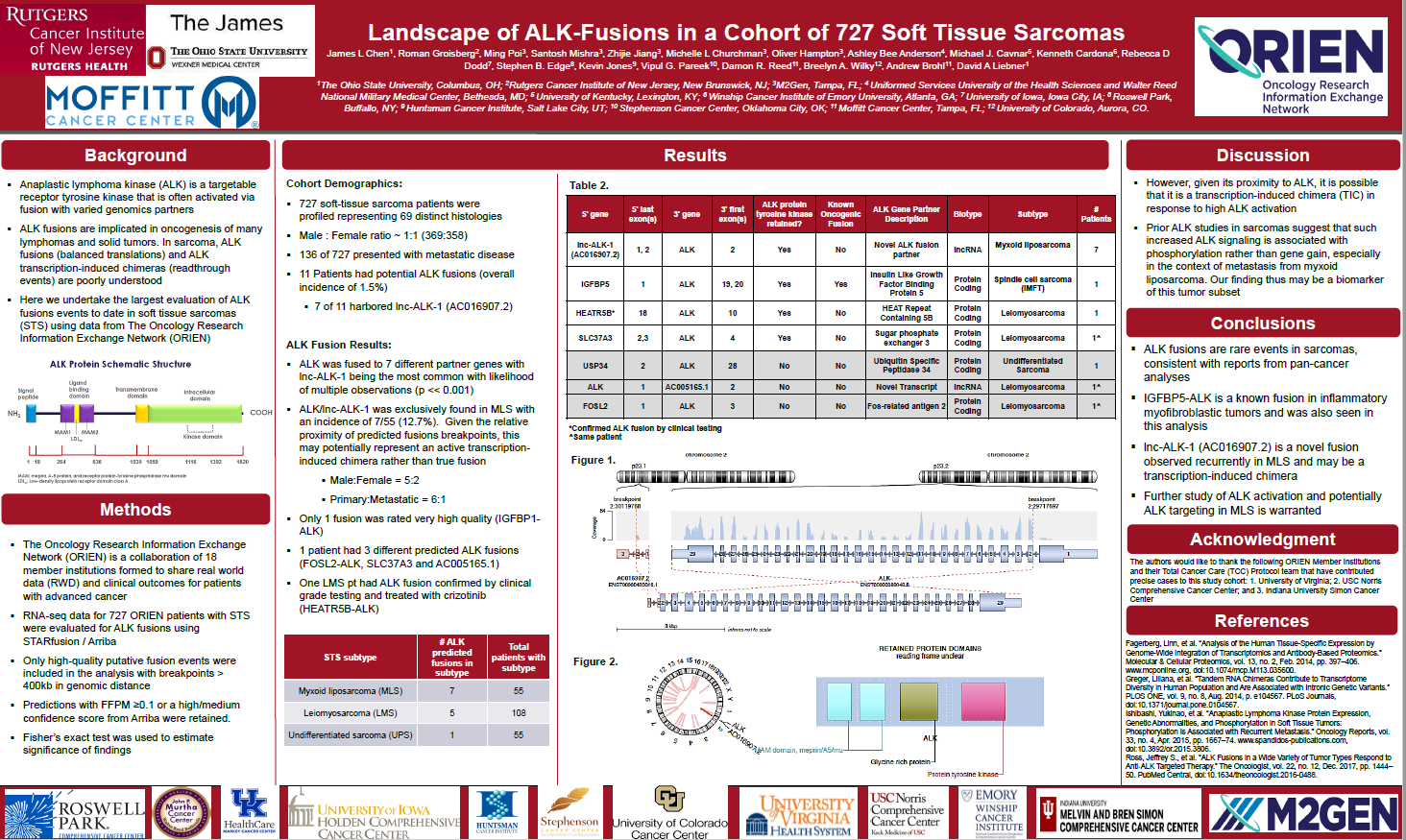Landscape of ALK Fusions in Soft-Tissue Sarcomas (STS)
November 30, 2020
Connective Tissue Oncology Society (CTOS) Poster Presentation (#205) - 2020 Virtual Annual Meeting
LANDSCAPE OF ALK FUSIONS IN SOFT-TISSUE SARCOMAS (STS)
Roman Groisberg1, James Chen2, Zhijie Jiang4, Michelle Churchman4, Ming Poi4, Santosh Mishra4, Oliver Hampton4, Ashley B. Anderson5, Michael Cavner6, Rebecca Dodd7, Stephen Edge8, Kevin B. Jones9, Vipul G. Pareek10, Damon Reed3, Breelyn A. Wilky11, Andrew Brohl3, David A. Liebner2
1Medical Oncology, Rutgers Cancer Institute of New Jersey, New Brunswick, New Jersey, UNITED STATES; 2The Ohio State University, Columbus, Ohio, UNITED STATES; 3Sarcoma Department, Moffitt, Tampa, Florida, UNITED STATES; 4M2Gen, Tampa, Florida, UNITED STATES; 5Uniformed Services University of the Health Sciences and Walter Reed, Bethesda, Maryland, UNITED STATES; 6University of Kentucky, Lexington, Kentucky, UNITED STATES; 7University of Iowa, Iowa City, Iowa, UNITED STATES; 8Roswell Park, Buffallo, New York, UNITED STATES; 9Huntsman Cancer Institute, Salt Lake City, Utah, UNITED STATES; 10Stephenson Cancer Center, Oklahoma City, Oklahoma, UNITED STATES; 11University of Colorado, Aurora, Colorado, UNITED STATES
Acknowledgement- The authors would like to thank the following ORIEN Member Institutions and their Total Cancer Care (TCC) Protocol team that have contributed precise cases to this study cohort: 1. University of Virginia; 2. USC Norris Comprehensive Cancer Center; 3. Indiana University Simon Cancer Center; and 4. Winship Cancer Institute of Emory University
Objective: Anaplastic lymphoma kinase (ALK) is a receptor tyrosine kinase that can be constitutively activated via a fusion with a variety of gene partners. These fusions are implicated in oncogenesis of many cancers and targeted ALK therapy is poorly understood. Here we undertake the largest evaluation of ALK fusions to date in STS.
Methods: The Oncology Research Information Exchange Network (ORIEN) is a collaboration of 19 member institutions formed to share real world data (RWD) and clinical outcomes for patients with advanced cancer. The ORIEN AVATAR program, launched in 2016, generates comprehensive whole-exome sequencing (WES) and transcriptome sequencing (RNA-Seq) for a subset of high-risk patients, including >1000 patients with STS, enrolled at ORIEN member institutions. We evaluated the landscape of ALK fusions identified as using the RNA-Seq genomic pipeline for STS patients in the ORIEN Avatar program. A consensus calling methodology (STARfusion, Arriba) was implemented for fusion detection. Only high-quality putative fusions were included in the analysis. High-quality is measured using (Fusion Fragments Per Million total reads) FFPM >0.1 and a high or medium confidence score from Arriba indicating that the fusion prediction has an associated likelihood that the transcript is aberrant (not previously identified in healthy tissue), has underlying evidence for genomic rearrangement, and is not an artifact.
Results: Of 1037 soft-tissue sarcoma patients profiled, representing 76 distinct STS histologies, 12 ALK fusions were noted which translates to an overall incidence of 1.2%. Histologies included myxoid liposarcoma (MLS) (7/48), leiomyosarcoma (2/143), IMT (1/25), well-differentiated liposarcoma (1/36), undifferentiated sarcoma (1/64). Male:Female ratio was 7:5. Median age at diagnosis was 53.6 years (34.3 to 66.4). ALK was fused to 7 different partner genes with lnc-ALK-1 being
Median age at diagnosis was 53.6 years (34.3 to 66.4). ALK was fused to 7 different partner genes with lnc-ALK-1 being the most common. Other binding partners are noted in the table. 7/11 patients were metastatic at presentation. 9/11 patients with ALK fusion remain alive after median 3.1 years follow-up. Each of 2 deceased patients had OS 2.9 and 3.3 years. One LMS pts had ALK fusion confirmed by clinical grade testing and treated with Crizotinib. Of note, Inc-ALK-1 was present in all 7/48 (14.5%) MLS. All contained the pathognomonic FUS-DDIT3 fusion.
Conclusion: Consistent with prior reports, ALK fusions are a rare event in sarcomas seen in the previously reported LMS and IMFT subtypes. Interestingly, the lnc-ALK-1 gene was also seen commonly in myxoid liposarcoma. Further work to characterize the mechanism of this fusion is warranted.
